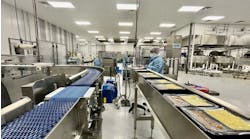Global warming is making things hotter for refrigerants.
The lifeblood of a mechanical refrigeration system is refrigerant that is compressed, then allowed to expand so it becomes cold. For a long time, the only considerations in choosing mechanical refrigerants were cost, effectiveness and safety. However, the potential for refrigerants – especially in industrial systems – to harm the environment and heighten global warming are increasingly driving choices for refrigerants, and the systems that use them.
Ammonia has traditionally been the workhorse, go-to refrigerant, especially for the biggest industrial systems. That appears unlikely to change, since ammonia is cheap and effective.
“Our food & beverage customers have asked us to compare the costs of alternate refrigerants to ammonia, but we’ve not seen a demand increase for these types of systems,” says Doug Stricker, senior manager of refrigeration engineering at design/construction firm Gray.
But ammonia isn’t suitable for all applications. Its primary problem is high toxicity if it leaks and is ingested. That can be controlled through alarm systems, but ammonia leaks have still caused deaths in several food processing plants. The danger has led some companies to look for alternatives to ammonia, in some cases prodded by local regulations restricting or forbidding its use.
Goodbye to CFCs
For a long time, the primary alternative to ammonia, especially in smaller systems, was chlorofluorocarbons (CFCs). The most common CFC was R22, which was ubiquitous in everything from home air conditioners to industrial systems. But CFCs were implicated in atmospheric ozone depletion, an issue that gained urgency as a hole in the ozone layer widened over the South Pole. This led to their banning under the Montreal Protocol, a 1987 international treaty that was enforced in the U.S. through the Clean Air Act.
“It was such a huge installed base that people still have systems that they’re not ready to replace. They’re still running, they still have value,” Allgood says. “So that’s been a big challenge for the industry, what to do with the existing base.”
When a legacy R22 system needs topping off, it has to be done with R22 that has been reclaimed from other systems. When an R22 system is dismantled, Allgood says, its refrigerant is often extracted, cleaned, bottled and resold. “The reclaim part of the business is going to be more and more important going forward,” he says.
R22 can be replaced in legacy systems with a more environmentally benign alternative. The go-to refrigerant for that scenario is R449a, Allgood says. Other alternatives are available, but they often entail slight alternations like different lubricant for the compressors or new elastomer seals or gaskets.
Not interchangeable
In most cases, however, swapping out a refrigerant is not that straightforward. Most of the environmentally benign alternatives to CFCs can’t be used in older systems.
In some cases, a refrigerant is incompatible with an existing system’s piping, valves and other structural components. In others, it presents hazards that the existing system is not equipped to handle. If the system is designed for a refrigerant with low toxicity and/or flammability, replacing it with one that’s more toxic or flammable presents safety issues.
Toxicity and flammability, the two major hazards associated with refrigerants, are rated according to a scale standardized by the American Society of Heating, Refrigerating and Air-Conditioning Engineers (ASHRAE) and other organizations. It’s a two- or three-character code, with the first letter, A or B, denoting low and high toxicity, respectively. The remaining characters denote flammability, starting at 1 for negligible flammability and going up to 2L, 2 and 3. Thus, an A3 refrigerant has low toxicity but high flammability, while a B1 would be the reverse.
The other number that is starting to affect refrigerant choice is directly related to environmental concerns. Global warming potential (GWP) is a measure of the negative impact that a gas, once released, will have on Earth’s atmosphere. It’s a calculation of the heat that the gas will absorb relative to the amount of heat absorbed by the same volume of pure carbon dioxide. So, for instance, one pound of a refrigerant with a GWP of 300 will retain the same amount of heat as 300 pounds of carbon dioxide.
Staying ahead of regulations
End users who are trying to decide on a new refrigerant – or, more often, a new refrigeration system – have to decide how to balance GWP with other considerations like safety and efficiency. One of the biggest considerations will be environmental regulations.
As they often are, regulations are a moving target for refrigerants. As Stricker puts it, “The regulatory situation with [fluorinated] refrigeration seems to change with each administration and its views on climate change.” Nonetheless, current federal regulations mandate refrigerants under 150 GWP for new installations.
That creates new challenges for refrigerant manufacturers. “There’s always some tradeoffs,” Allgood says. “Sometimes we can make a refrigerant with 300 GWP that has a lot better energy performance than something less than 150 GWP. But depending on where the energy regulatory authorities draw the lines, we can design refrigerants that operate there.”
With this situation in mind, Chemours has developed two lines of R-class (fluorinated) refrigerants: the XP class, for retrofits, and the XL class, for new installations. The XL refrigerants are rated A2L, meaning low toxicity but moderate flammability. Using them may require a refrigeration system to install safety measures like extra leak detectors, Allgood says. “There are safety mitigations that are becoming mainstream to enable this class of 2L refrigerants.”
An alternative to fluorinated refrigerants is liquid carbon dioxide, which can be used in “cascade” refrigeration systems. These use liquid CO2 in tandem with ammonia or a fluorinated refrigerant. That refrigerant cools the CO2, which then enters and chills the evaporator coils, the source of the system’s cold air.
Mike Anderson, sales manager for Air Management Technologies, says many companies look beyond the refrigerant’s ASHRAE rating to the total life cycle impact of their refrigeration systems. This includes factors like energy consumption, electrical generation, carbon footprint and condenser water usage.
“Most food processors have a sustainability policy tied to refrigerants,” Anderson says. “Each organization has their own decision matrix: refrigerant sustainability, capital cost, safety and safety plans, energy consumption and, in many parts of the country, who can maintain and repair the systems.”
Anderson says this holistic approach makes more sense over the long run: “Today my feeling is most corporations are looking to be ahead of the regulatory curve due to their sustainability policies and being good corporate citizens.”




